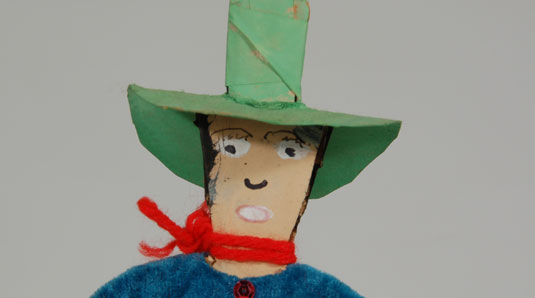Diné - Navajo Cardboard Navajo on a White Horse [SOLD]
+ Add to my watchlist Forward to Friend
- Category: Other Items
- Origin: Diné of the Navajo Nation
- Medium: cardboard, fabric, beads, paint - includes metal stand
- Size: 13-3/4” height x 11” length
- Item # C3753.55 SOLD
Authors and collectors Chuck and Jan Rosenak are largely responsible for bringing to attention the craft now known as Navajo folk art. They credit Navajo trader Jack Beasley from Farmington, New Mexico, for bringing the makers of this wonderful creative art form to their attention. When beginning their search for folk art artist on the Navajo reservation, the Rosenaks defined folk art as “work by untrained, self-taught artists that is nonutilitarian, highly personal, even idiosyncratic. The craft may be derived from communal traditions, but something personal must be added to qualify it as art. In other words, the craft may be learned, but the art is self-taught.”
The first item of Navajo folk art discovered by the Rosenaks was a mud toy on display at the Wheelwright Museum of the American Indian in Santa Fe during a trip at Christmas, 1983. One of the mud toys was by Mamie Deschillie. A trip to Farmington, New Mexico, to see Indian trader Jack Beasley led to the Rosenaks meeting Mamie at her home on the reservation. They immediately recognized her as one of the “superstars” of contemporary Navajo folk art.
Since Navajo cannot take out a mortgage on their property (because it is government owned) they have traditionally relied on reservation traders as a local bank from which to borrow money and they leave their valuable jewelry with the trader as pawn or collateral. Trader Jack Beasley asked two of the Navajo women, from whom he accepted jewelry as pawn, if they could bring in something from their childhood. Independently, both brought in traditional mud toys which they remembered from childhood but which had not been made since the 1940s.
 From this exchange between trader and Navajo developed a trade in Navajo mud toys. Mamie Deschillie was one of the two Indians Beasley had approached. Mamie continued making mud toys for the trader and began making other folk art items, the most creative being cardboard cutouts. This was a creation from her fertile artistic mind and not from childhood memories.
From this exchange between trader and Navajo developed a trade in Navajo mud toys. Mamie Deschillie was one of the two Indians Beasley had approached. Mamie continued making mud toys for the trader and began making other folk art items, the most creative being cardboard cutouts. This was a creation from her fertile artistic mind and not from childhood memories.
This cardboard cutout is of a dandily-dressed Navajo male riding a white horse. Both are cutouts from cardboard and enhanced with paint and fabric. The male wears pink trousers and a print shirt and a green Navajo-style hat. The horse is painted white with a black yarn tail and a fabric saddle blanket. The close location of the eyes of the horse add charm to an otherwise white piece of cardboard. He has a comical look that one cannot help but greet with a smile. The figurine is provided with a metal stand for display. The artist wrote her name across the front legs of the horse.
Condition: all four legs of the horse have a crease but otherwise it is in very good condition.
Provenance: from the extensive collection of a Santa Fe resident who is unfortunately moving to another city and found it necessary to greatly reduce her collection.
Recommended Reading: The People Speak: Navajo Folk Art by Chuck and Jan Rosenak

- Category: Other Items
- Origin: Diné of the Navajo Nation
- Medium: cardboard, fabric, beads, paint - includes metal stand
- Size: 13-3/4” height x 11” length
- Item # C3753.55 SOLD



